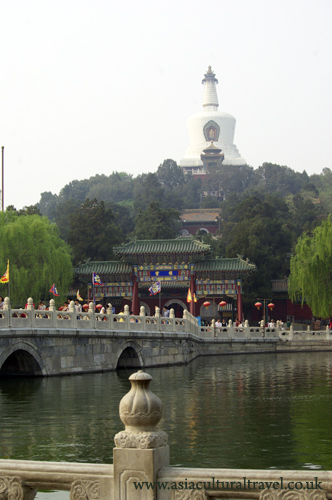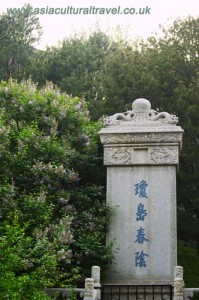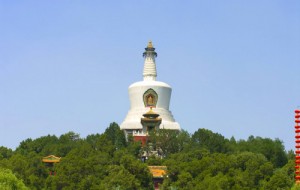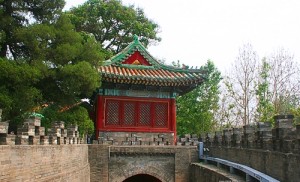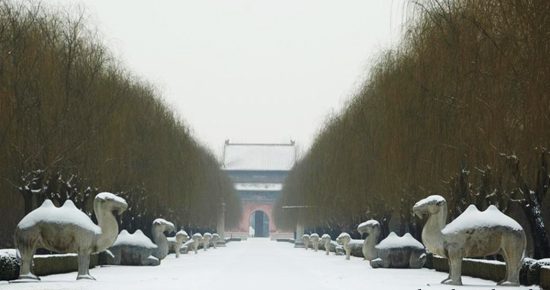
There are a total of 13 mausoleums for Emperors of the Ming Dynasty (1368-1644) here, so it is generally called the Thirteen Mausoleums. In fact, in the mausoleums you will find 13 emperors, 23 empresses, 2 princes, about 30 imperial concubines and even 1 palace eunuch, who were all cremated and placed in this group of tombs.
Shendao
“Shendao” in Chinese means “the way of the spirit” or “the sacred way”. It is 7 kilometres long, and stretches from the Memorial Arch through to the gate of the main tomb, Changling Mausoleum (the mausoleum of Emperor Yongle).
The Memorial Arch is made of white marble and was built in 1540. It has 5 arches supported by 6 pillars, each with beautiful bas-relief carvings of qilin (Chinese unicorns), lions, dragons, other unusual animals and lotus flowers pared into them.
After the Memorial Arch, you’ll find the Great Red Gate, which was built in 1426. About 457 metres away from the Great Red Gate, there stands the Tablet House. A marble column, known as a Mubiao, stands at each corner of the Tablet House. A Mubiao was an ornamental column which was erected in front of a tomb, much like a tombstone. A huge tablet, which is 6.5 metres high, stands in the middle of the Tablet House and rests on the back of a marble tortoise.
The most distinctive work of art in the mausoleums is known as the “avenue of stone animals and statues”. Avenues of stone animals and statues can often be found at the entrance to imperial mausoleums from the Han Dynasty (206 BD— 220 AD), but none of them are as famous as this one.
The avenue, which boasts 36 stone animals and statues, has two columns (called wangzhu in Chinese) on either side of the entrance. They are hexagonal, with a cloud design carved into them, and the top of them is shaped like a cylinder. The animals included in the avenue were specifically chosen because culturally they are all symbolic. There are lions, which were symbols of power. There are xiezhi, which were mythical feline beasts that were said to be able to distinguish right from wrong and thus were symbols of justice. There are camels, which were symbols of transportation, and elephants, which were symbols of peace. There are qilin, another mythical animal with a scaly body, a cow’s tail, deer’s hooves and a horn on its head, which were also symbols of peace. And finally there are horses, which were symbols of expedition. There are 24 stone animals in all. These beasts are followed by a group of 12 human statues (officials), which symbolize the funeral cortege of the deceased emperors.
Dingling Mausoleum
Dingling Mausoleum is the only one of the Ming mausoleums that has been excavated so far. The excavation lasted more than two years and took place from 1956 to 1958.
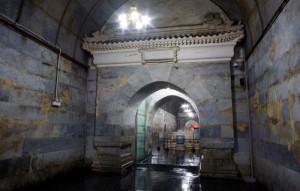 It is the mausoleum of the Emperor Wanli (1563-1620) and his two wives – Empress Xiaoduan and Empress Xiaojing. Empress Xiaoduan died only a few months before his death. Empress Xiaojing died in 1612, eight years before the emperor’s death, and was buried in a nearby tomb reserved for imperial concubines. Since Xiaojing did not hold the title of Empress at the time of her death, she wasn’t initially permitted the privilege of sharing the emperor’s tomb.
It is the mausoleum of the Emperor Wanli (1563-1620) and his two wives – Empress Xiaoduan and Empress Xiaojing. Empress Xiaoduan died only a few months before his death. Empress Xiaojing died in 1612, eight years before the emperor’s death, and was buried in a nearby tomb reserved for imperial concubines. Since Xiaojing did not hold the title of Empress at the time of her death, she wasn’t initially permitted the privilege of sharing the emperor’s tomb.
Xiaoduan never bore the Emperor a son, whilst Xiaojing gave birth to one son, who then became the emperor after Wanli’s death. Although Xiaojing’s son was only emperor for 29 days, he left the throne to his son. When Xiaojing’s grandson ascended to the throne and became the emperor, he promoted his grandmother to the rank of queen dowager and it was decided that her body should be moved into the imperial mausoleum.
The construction of the mausoleum started in 1584, when Emperor Wanli was only 22 years old. The mausoleum was finished when he was 28, and he had to wait another 30 years to finally use it.
When the Ming Dynasty collapsed in 1644, the tomb was damaged in a peasant uprising led by Li Zicheng and was not restored until the reign of the Qing Emperor Qianlong (1736-1795).
The underground palace is 27 metres below ground level and has a total surface area of 1,195 square metres. It is divided into 5 chambers – the antechamber, the middle chamber, the rear chamber and the left and right annex chambers. The vaulted chambers are built of stone, without employing a single beam or column. The antechamber and central chamber form a long passageway, at the end of which is the rear chamber, with the two annex chambers set at right angles to it forming a T-shape.
